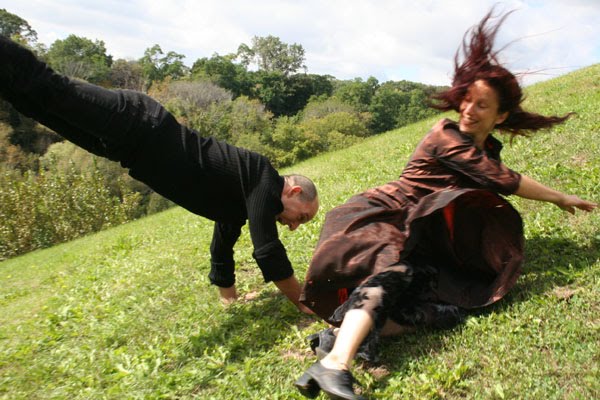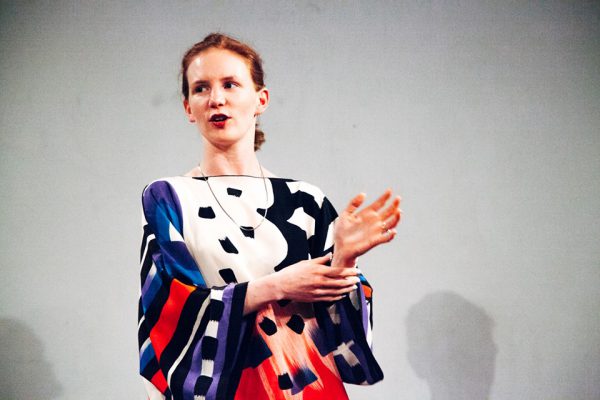Précis:
The following report, comprised of notes, recollections, conversations and conjecture, arose from a dialogue at The Dance Current regarding the emergence of a new, generational affinity to visual art, in particular performance art (which one may or may not consider to be a subset of visual art), evident in the dance community in Toronto. This essay takes the position that performance art is inextricably tied to visual art, that one guides the reading of the other and by now those influences are reciprocal and equitable. The examples cited, all recent and representative, necessarily varied and wide-ranging but never anomalous, establish a spectrum of relationships from dance to performance to sculpture.
“Dance and Objecthood” opens with a look at a featureless abstract sculpture that has been assigned more than corporeal representation; it is endowed with an autonomous bearing. The essay’s title alludes to the landmark 1967 essay by Michael Fried, “Art and Objecthood.” A polemic intended to debunk the legitimacy of minimal art, Fried’s arguments were deemed so cogent and original an account of the properties of minimalism that “Art and Objecthood” has since become the classic text making the case for minimal art.
The very term objecthood implies a level of self-determination on the part of the object. What might that mean? We begin to see it played out in a new engagement of objects in dance, where they become not props but protagonists, or more often antagonists, capable of bending the human body to its will.1
In September 2014, an ingenious group exhibition, Why Can’t Minimal, opened at the Justine M. Barnicke Gallery at the University of Toronto.2 A riddle without a question mark, a knock-knock joke that enlists its audience as straight-man, it essentially delivered a punch-line thesis: “‘Why can’t minimal’ who?”, “Why can’t minimal be funny.” That proposition upends the orthodoxy that minimalist art is so material, rational and sterile that it converts the supposedly neutral art gallery into a theatre in which the spectator becomes somatic player.3 Exhibit A in the case for Why Can’t Minimal might be Jon Sasaki’s A Minimalist Cube Shipped with Minimal Effort and Expense (2012), a twelve-by-twelve-by-twelve-inch hollow steel block affixed with labels and barcodes that track its uncrated transit back and forth from studio to exhibition. Sasaki’s Minimalist Cube oscillated between art object and package: from, a quasi-normative sculptural figure poised squarely on the floor finessed by ‘in-on-the-joke’ curators and art handlers who transposition the work from loading door to gallery, yet can only hazard a guess as to which side goes up, to an empty, hard-edged parcel in the routine, if unwitting care of anonymous couriers. As Sasaki unlocks a hidden transience with respect to the hitherto static sculpture, Why Can’t Minimal purports a psychological condition for such primary geometric objects (cubes and what have you) that exceeds any sculptural conventions of substitution for the body and endows it with a comic personality. The inanimate stand-in goes stand-up, so to speak.4
In dance training, personality routinely gets tamped down. The dancer’s discipline begins with conditioned sublimation of his or her individual identity and experience, let alone spontaneity and expression. The term corps suggests that steps, virtuosity and even physique ultimately belong to the ensemble, the chorus, which serves at the pleasure of the choreographer. This leaves dance in a curiously anachronistic position with respect to a new generational trend in the arts — interdisciplinarity.
Convergence amongst the distinctions of the stage — such as theatre and dance — combined with bridges between the once-distant realms of the stage and the gallery is generating a contiguous artistic mass. Contemporary dance, from modern and postmodern, to classical traditions such as ballet, may benefit from the resultant expansions and intersections of context and audience. Dance and art are tentatively (oftentimes more than that) beckoning to one another, through a shared revival of interest in the practices of 1960s and ’70s minimalism and post-minimalism. And as the latter designation suggests, it is hardly the first time this has occurred. However, each generation’s rediscoveries fulfill its particular needs, repeating, re-evaluating, reconstituting, even obliterating the progressions of its intervening predecessors. Initially, the results of these gestures may appear relatively misbegotten, ill-informed or amnesiac. To their credit, artists, performance artists, dancers and choreographers alike seem cognizant of these limitations, its awkwardness and occasional absurdity. What would be anathema to minimalist forebears, acknowledgement, moreover the requirement of an audience, is now overtly signalled. Through their attentions and incursions into one another’s customary domains, performance artist and dancers are respectively coming to know and appreciate the rigours and disciplines that differentiate them. Therefore it seems more appropriate at this juncture to consider the shapes of certain performance art and choreographic practices than to closely analyze the works that they produce. As exciting a moment as this is, its bywords remain exploration and transition.
A conspicuous historical example of the reconciliation of dance to art is the enshrinement of choreographic pioneers such as Merce Cunningham, Trisha Brown, Yvonne Rainer, and Steve Paxton at Dia:Beacon in New York State5 alongside masters of minimal and post-minimal art from the 1960s onward (such as Agnes Martin, Donald Judd, Sol LeWitt and Richard Serra; but also artists as idiosyncratic as Andy Warhol, Joseph Beuys, Bruce Nauman and Louise Bourgeois). Dance as determined by chance, system, modulation, somatics or the banishment of narrative corresponds to the negation of the expressive gesture in visual art. By contrast, yet implicitly under the same roof, the roots of performance art promoted subjective alternatives to the high formalism of these mandarin choreographers, often undermining the anonymity of the performer. Warhol’s camp, queered films, Beuys’s allegorical actions and social sculpture, Nauman’s antic obsessive/compulsive “gestures” and Bourgeois’s porous, vulnerable, contingent bodies, now delineate attractively strange and unsettled horizons not just for creators but spectators. Performance art simultaneously acts as a catalyst and remains a holdout in its firmly ingrained opposition to both the visual and performing arts. In 2015, it finds special status with a generation that has never known a time that it was not fully fledged.
A key locus for performance art and dance in Toronto is Dancemakers Centre for Creation, which completely overhauled its artistic strategy for 2014–2015. Many of its elements were devised by former artistic director Michael Trent, but following his sudden departure a year ago, the implementation has fallen upon Emi Forster and Benjamin Kamino, a team of young co-curators. Their program is (and isn’t) intensively about dance, with emphases on emergence and incubation, laboratory and development, intramural, professional and public discourse and dialogue. “As a centre for everyone [Dancemakers] must pose clear, simple questions which allow for a broad range of answers: ‘what is dance?’, ‘why are you dancing?’, and ‘how do you define what you do right now?’”6 Dancemakers variously positions itself in the community, through a banner workshop, “Make. Make Public,” and ongoing works-in-progress labs, as well as partnerships in the Progress International Festival of Performance and Ideas and bringing the momentous Yvonne Rainer Transmitting Trio A project to Toronto.7 “Public Season One,” the first half of its performance series, almost lost amid so much activity, introduced its inaugural two resident artists, Dana Michel of Montréal and Zoja Smutny of Toronto.
Michel earned wide acclaim in 2014 at New York’s American Realness festival, a bellwether in the coalescence of theatre, dance and performance art. With Dancemakers, she developed and presented a compelling ensemble re-interpretation of her signature solo work, 1976, here titled 1976, have several. Robert Abubo, Amanda Acorn, Ellen Furey and Simon Portigal became a huddled, tetra-phased embodiment of Michel’s self-portrait, donning and discarding the recognizable elements of her costume and attendant props, finding poignant voice in songs and, oddly enough, making and sharing coffee. When the dancers occasionally spoke, their words hung palpably over the stage like cartoon speech balloons. During the performance, the audience offered ordinarily incongruent and genuinely uninhibited interjections and laughter. 1976, have several premiered in a raw, tentative state that rapidly cohered over the course of its short run. Michel’s transition from performer to choreographer was convincing.
Smutny, funny and engaging herself, spoke of the first months of her residency. “Everyone there is so young. Emi and Benjamin are only in their twenties. Typically, Dana and I found each other to be closest in artistic sensibility. Simon and I rarely worked on movement. Mainly we talked. His ideas would never occur to me. He really wanted to expose himself to the audience through lace stockings. I went along with it.” Smutny grew up in a dissident artistic family in Brno, the cultured Czech city known for its modern theatre traditions, also the birthplace of the renowned author and activist, Milan Kundera. Hence, free speech and permission remain important values for her. Smutny trained in choreography, yet was never part of a company herself. Smutny returned to Toronto (where her family moved in the 1980s) following her MA in Solo/Dance/Authorship at the Inter-University Centre for Dance in Berlin (HZT). Often working collaboratively with photographers or composers, she produced numerous short video works that feature improvisational movement through secretive public space; Smutny conforms to or traverses the corners and seams of place, using one-time rites, which in their singularity are therefore not ritualistic. Much of her method hinges on conversation. Her body, sensitive to movement, acts as a conduit to the perception of another, sensitive in other ways. (Her question is: “How can we work together in order to work alone?”8) Smutny is unusually sensitive to the corporeal integrity of objects. Chairs are not simply furniture for the human posture, but vessels of time, use and custom. Asked how she defines choreography, Smutny demonstrates it physically by an impulsive rearrangement of jars on a tabletop.
The curatorial partnership at Dancemakers has inherited the artistic vision of Trent; Forster assumes the organizational, mediating role and Kamino, only recently a dancer in the company he now leads, plays resident id, introducing performances in un-tucked flannels with a beer bottle dangling at his hip. His instinct suits a newly launched, over-ambitious and variegated program that is still figuring out what works. The following exchange closed out a conversation, “What Is ‘Dance?’”, between Kamino and Toronto performer and director Coman Poon, conducted for the Progress Festival.
CP: I am reminded of learning in developmental psychology about the phenomenon of double touch. [We] derive a sense of physical limit/embodiment when we touch inanimate or other animate surfaces and compare it to the double-touch experience of touching our own bodies and simultaneously feeling both our own touch as well as the experience of being touched. This registers neurologically as ‘the limits of my body’.
BK: [Ah-h] yes. We learn our limits only to despise them.
CP: Or to find that [they are] porous … that more than touch informs our sense of vibrational, energetic and psycho-sensorial limit. In this way, there is a transcendence of the body happening too. Perhaps.
BK: [Ah-h], this is so hopeful. You are an optimist (in this circumstance that is)!9
Double touch corresponds to Jon Sasaki’s A Minimalist Cube, dichotomously perceived and positioned as a vessel and a body. Perhaps only by stepping outside of dance as a distinct practice, reaching back to it from another place, another set of artistic values and registers, can Dancemakers answer the what, why and how questions that it poses at the core of its new mandate. In its new-found talkativeness, the organization seems to be, improbably, on the right track.
While the diversity of performance art defies classification, one relevant have or have-not distinction involves language. One side assiduously mines and refines the vast linguistic bedrock into words, texts, diction and utterances that it puts on prominent display. The other is vigilantly abstinent, finding its syntax in the attitudes of the body and the material metonymy of objects. Evidence of both positions abounded at the tenth edition of the 7a*11d International Festival of Performance Art in Toronto, which ran from October 29 to November 2, 2014. A biennial exposition of the legacies and politics of performance, the festival gathers legends and upstarts, sages and jesters, masters and mavericks. Night after night, the performances were packed. A frequent motif was the irreverent or iconoclastic retrospective critique of the personal, reframing the inherited legacies of prior generations. Alberta artist Terrance Houle’s Friend or Foe #7 (iisistsikóówa) went so far as to proclaim his retirement from the field of performance art altogether, via assault and denunciation of his own practice. Houle adroitly played both sides of language against the other. He was ostensibly mute, communicating with hand gestures that no one in the audience grasped. (In the pre-colonial sign language that parlayed the multitude of Aboriginal tongues of the Great Plains, he repeated “I am Blood. I came here to perform. I am Buffalo Rider.”) Thugs came on, littered Houle’s sanctuary with prescriptive academic and aesthetic texts, castigated his transgressions, violently stripped him of his street clothes and chucked breech clout and breastplate on his defeated body and ran off. Left in solace, he sang almost inaudibly in the vanishing Blood language, took succor in the oral fixative of a cigarette and shockingly snipped off his long traditional braids. Such irrevocable action is unthinkable in the repertory bound parameters of dance. In two quick cuts, pieces of the body became mere things, discarded and buried in the final sacrament of the performance.
Other artists at the festival followed comparable courses of self-abnegation more reductively. British performance artist John Court, now resident in Finland, exorcised his UK elementary education, which deemed him an abject failure due to a severe learning disability. He did so by trudging a prisoner’s circuit in a former classroom for six hours. Andrée Weschler, of Singapore, silently enclosed herself for an anxiously long time in a black garbage bag. The audience heard her muted distress from within. Only after several minutes did she manage to force a foot through to light and fresh air. Says Weschler, “It’s about the breath, separation, darkness and claustrophobia.” Again, whatever happens here, it’s real. Such actions simply cannot be reprised.
Several choreographed works were performed at 7a*11d, often by artists bringing very different frames of reference. Regina’s Gary Varro went to architecture school. He considers thresholds between domestic and exterior space, the private and the public as connoting the liminal bounds of queerness. His identity remained visually absent throughout the six-hour duration of Soft Peak, his bodily form abstracted through stage devices. Entering the space, the only evident forms are crumpled heaps of white Tyvek and gold laminated foil. One piece begins to slither, crinkle, stand and extend ever so slowly toward another. This white form engorges a limp skin of gold. Something unseen crawls from one to the other, suggesting perpetual chrysalis or florescence. The materials temporarily retain the form that evacuates them and then slowly collapse. Varro’s performance is a treatise on the receding sculptural, masculine form. Think of Auguste Rodin’s Monument á Balzac (1891–1897), portrayed wrapped in a heavy, full-length gown from which only his head and foot partially emerge, but which is almost as well-known as a dynamic, corpulent contrapposto nude in its numerous studies.10 Varros arouses modern performance-art signifiers and precedents too: the white and gold skins refer to Beuys, Nauman and Matthew Barney, while the sheathing alludes to Michael Morris, a.k.a. Marcel Dot, Miss General Idea 1971–83.11
Brooklyn’s Anya Liftig contrasts with Varros’s veiled auto-critique of masculinity. She studied dance seriously, from childhood ballet to high-school scholarship at the Martha Graham School of Contemporary Dance. Her body changed and Liftig lost the physical conditioning, followed by the motivation to continue. However at 7a*11d she showed Know It Well, a new ‘face ballet’, performed via a live video projection fed from a tent erected in the audience’s midst. A mounted camera aimed tightly at her head isolates how Liftig trained herself to move her facial muscles independently. Brows, cheeks, nostrils, lips, chin, creases and dimples are set into autonomous motions, bringing her balletic sense of structure and timing to play. Liftig’s anti-heroic focus is the mouth, as she says “taste before sight; the trap door & dark cavity; sensual, sexual; feminine, feminist.”
Attending 7a*11d (although not participating) was Bridget Moser, who has recently established a much admired profile in performance art and beyond. Moser’s specialty is prop-based comedy. Moser converses with prosaic, everyday objects, anthropomorphically scaled to her own body. She tries things on, testing the compatibility of their physique, gauging their potential sentience or capacity for intelligent reply. It could be a lampshade, folding chair or answering machine, each a plausible prosthetic extension of the body and willing, wilful partner, each with lessons of its own to share. Her routines are highly verbal and mostly (but not always) one-sided. Moser has garnered an enthusiastic following as a founding regular of the avant-gard stand-up comedy group Doored, based at Double Double Land in Toronto’s Kensington Market. In May 2014, she co-choreographed a short solo work with artist Chris Curreri, as part of Toronto Dance Theatre’s On Display.12 Full of Holes put TDT corps member Alana Elmer between two carpeted “cat condos,” each of which she silently explores with all of her limbs, extremities and protuberances. Not surprisingly, Moser herself was an irrepressible childhood dancer, who never gave in to the directive to restrain her personality. Nor has she outgrown that spirit, now nestled fortuitously into her performances, striking lithe, exaggerated poses with a deadpan expression. Given Moser’s predilection for clumsy domestic objects that coincidentally evince reductive or minimalist sculpture, she brightly states: “I am drawn to the very generic, impoverished nature of these forms, begging for an identity.”
In Moser’s articulation, objecthood assumes sense and significance. Identity, dispossessed from the exclusive realms of individuality, community or heritage, may reside in language and things, however mundane, too, as well as people. Perhaps people can inquire of things, listen without a loss of humanity, move to and with them. This does not cling to materialism. As the world seems to be going, it may be adaptive consciousness.~
“Dance and Objecthood” is the third feature in the series Hard Art with writing by Montréal’s Philip Szporer and Vancouver’s Janet Smith in the May/June 2015 print issue.
1 Another reading of the title [“Dance and Objecthood”] might lead to its unwritten algebraic sum, along the lines of “comedy equals tragedy plus time.” What other bi-verbial equation could come to the same result? For your consideration: comedy equals dance [movement] plus objecthood [inertia].
2 Why Can’t Minimal, curated by John G. Hampton, was on view from September 2 to October 19, 2014.
3 See Michael Fried’s seminal essay, “Art and Objecthood,” originally published in Artforum (Summer 1967), widely and canonically reprinted ever since.
4 Implicit here is a unique exemption for gallery etiquette. If this is comedy, then laughter, repartee and heckling are permissible. This also seems to be taken as an appropriate manner by new audiences for performance art, theatre and dance.
5 Dia:Beacon, located in a 300,000 square-foot former factory building along the Hudson River in Beacon, New York, opened in 2003 as the long-term exhibition site for the collection of the Dia Art Foundation.
6 See dancemakers.org/what-we-do.
7 Transmitting Trio A (March 20 to 28, 2015) was presented by Gallery TPW in collaboration with FADO Performance Art Centre, in partnership with No Readings After the Internet, Dancemakers and the Art Gallery of Ontario. Curated by Jacob Korczynski and Kim Simon, the project encompassed visiting lectures by Yvonne Rainer and Sara Wookey, “transmitter” of the Rainer’s choreography, Trio A (1966). Ten Toronto performance artists, choreographers, dancers and visual artists were publically instructed and rehearsed through the work by Rainer and Wookey. The week’s events also included public discussions and a reading. In addition, Toronto performance artist Bridget Moser [see below] created a newly commissioned video work titled A Fence Is a Type of Movement, in which she contemplates the somatic potential of an inflatable love seat in the confines of an unfinished interior renovation.
8 See profile of Smutny at http://dancemakers.org/zoja-smutny/.
9 See full interview text at http://www.comanpoon.com/what-is-dance-a-conversation-with-benjamin-kamino/.
10 In both its nude and cloaked versions, Rodin’s Monument á Balzac seems the intentional antithesis of its period to Edgar Degas’s iconic La petite danseuse de quatorze ans (c. 1881), which was originally sculpted in wax. While the two-thirds life-size ballerina in tutu has arms clasped behind her legs arched back in demure equipoise, the brooding, cloaked Balzac appears upright against all elements and his nude variants, arms crossed above his pot belly, clomp in heavy-footed, willfully anti-balletic stride. (The poses, Balzac wrapped and unwrapped, were not identical, endowing them even more unsettled transience.) Rodin even produced a study of the standing dressing gown, as if shed by its figure, except for a vestigial left foot protruding at its base.
11 Toronto’s queer communities established especially early and exemplary interdisciplinary conduits between visual arts and dance. Another relevant, more recent correlation to Varro’s performance (and ultimately Rodin) can be drawn to Toronto artist Luis Jacob’s Dance for Those of Us Whose Hearts Have Turned to Ice, Based on the Choreography of Françoise Sullivan and the Sculpture of Barbara Hepworth (With Sign-Language Supplement) (2007), created for Documenta 12. In his video installation, Jacob paid homage to Québecoise painter and dancer Françoise Sullivan’s seminal 1948 performance for camera, Danse dans la neige, comparably portraying the body and personality, swaddled and naked, of Keith Cole, queer performance-art doyen[ne], dance maven and rapier wit, in his improvised dance in the snow.
12 The other visual-artist guest choreographers for On Display were Oliver Hussain and Aleesa Cohene. Hussain’s object-based Not wanting to make a decision, but standing firm anyway paired Naisha Wang in a near slapstick duo with a gauzy pop-out tent. Cohene later transposed her prop-free Hard Moves, performed by Mairi Grieg, into an essential ten-minute element of I Know You Know, her solo exhibition at Oakville Galleries (September 14, 2014 to January 4, 2015) , re-titled I’m Not Surprised, performed once a month in the gallery by Grieg near an aromatic still-life of onyx grapes, both directly on the floor.





